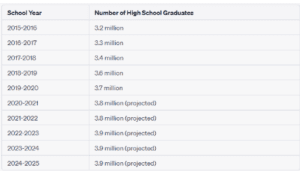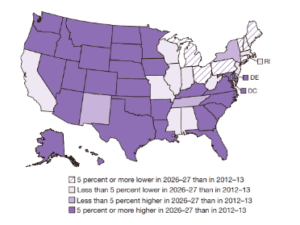For years, educators and policymakers have sounded the alarm about an impending “enrollment cliff,” a predicted sharp decline in college enrollment rates as the number of high school graduates declines. In this era of shifting education dynamics, the value of higher education is being reevaluated, with an increasing number of high school graduates opting out of traditional college paths.
High School Graduation Rates – There’s Plenty of Students
Over the past five years, the number of high school graduates in the United States has been steadily increasing. In the 2015-2016 school year, there were 3.2 million high school graduates in the United States. By the 2019-2020 school year, that number had increased to 3.7 million. Projections from the National Center for Education Statistics show that this trend will continue over the next five years, with the number of high school graduates expected to reach 3.9 million by the 2024-2025 school year.
Here’s a table summarizing the number of high school graduates in the United States over the past five years and the next five years according to the National Center for Education Statistics:

Enrollment Cliff Statistics
In fact, high school graduates are projected to be higher in 2026–27 than in 2012–13 for 32 states, highlighting the unexpected trend. However, demographic changes are significant. The National Center for Education Statistics reports that the number of White high school graduates is expected to decline by 7% between 2019 and 2029, while the number of Hispanic and Asian/Pacific Islander graduates is projected to increase by 30% and 14%, respectively.

The changes in diversity are important to recognize as students from certain ethnic groups have been less likely to enroll in college. According to the National Student Clearinghouse Research Center, Hispanic students have the lowest enrollment rate among all ethnic groups, contributing to the concerns about the enrollment cliff.
The Real Story: The College Going Rate
Let’s delve into the college enrollment rates in recent years and examine the factors contributing to the enrollment cliff:
Data: National Student Clearinghouse Research Center

As you can see, the college enrollment rate has been declining over the past several years, driven in part by the availability of good career options for High School graduates. With an increase in recruiting efforts by vocational and trade schools, the boom in certificate education, quality online education options like LinkedIn Learning, and a constant national narrative about the increasing cost of a college education, the college enrollment rate decline may be at more at risk than any demographic change.
Addressing the Enrollment Cliff: A Wake-Up Call from Indiana
One look at what has happened in Indiana is a wakeup call. A recent announcement by the state’s commissioner for higher education, Chris Lowery, in Indiana’s College Going Rate Experiences a Sharpe Decline, says, “The future of our state is at risk, and I’m joining leaders around the state in sounding the alarm. Indiana’s college-going rate fell to 53 percent for the class of 2020 (a 6-point drop from 2019 and 12-point drop from 2015). This is the lowest rate in at least a generation and presents stark challenges which must be addressed with urgency and thoughtfulness.”
He continues that “Our new data highlight alarming educational trends, particularly for males, and Black, Hispanic and Latino, and low-income students, who saw the largest declines in college-going rates. We must leverage programs that work to close these gaps, including Indiana’s 21st Century Scholarship, which has closed the college-going achievement gap for low-income students across all races and ethnicities. Unfortunately, not enough eligible students are enrolling, because they don’t know about it or have the support to apply,” says Mr. Lowery.
The facts are in front of us. There are plenty of students to fill our classes. Yes, the demographics are changing but that does not mean the college-going rate must drop. The real pressure is improving the value proposition of what you have to offer at your institution, reinventing your programs to accommodate the changing student needs rather than assuming that you are competing for a small pool of students. Drive change and focus on shaping your narrative in the market.
A New Approach to Address the Enrollment Cliff
With a new lens comes a new approach that is more optimistic and challenges conventional thinking. At 3E, our results show that schools of all types in all locations can grow in this environment. Over 80% of 3E clients are even or well ahead of last year in both applications and deposits. Most institutions that are ahead in deposits are seeing double-digit growth.
Conclusion
In conclusion, the enrollment cliff may not be a foregone conclusion as previously predicted. While demographic changes are occurring, the real challenge lies in enhancing the value proposition of higher education and adapting to the evolving needs of students. The trends in college enrollment rates call for innovative programs and a new approach to addressing the changing landscape of education.
If you are looking to learn more on how you can better plan for changing enrollment, take a look at the 3E ForwardIQ Forecast.


